How Toyota Hybrid Engine Works? It is a sophisticated combination of gasoline engine and electric motor designed for optimal fuel efficiency and reduced emissions, and at millertoyota.net, we provide detailed information and services to help you understand and maintain this innovative technology. Visit millertoyota.net to explore our range of Toyota hybrid vehicles and discover the benefits of hybrid technology. Learn about hybrid vehicle maintenance, fuel efficiency, and electric motor performance.
1. What Exactly is a Hybrid Vehicle?
Simply put, a hybrid vehicle combines two or more power sources. Typically, this involves pairing a traditional internal combustion engine (ICE) with an electric motor. Toyota pioneered the full hybrid system, which uses both a battery-powered electric motor and a gasoline-powered combustion engine, which can work together or independently. This system, first introduced with the Prius, has sold over 15 million units worldwide.
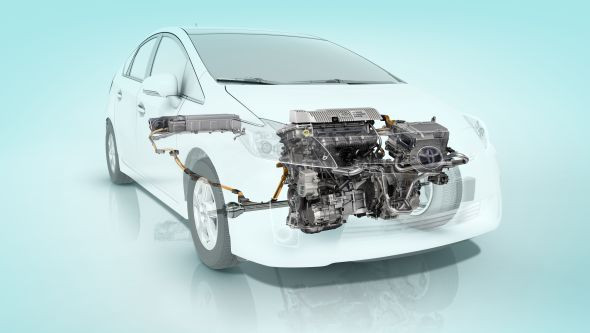 Hybrid Synergy Drive
Hybrid Synergy Drive
1.1 What Are The Different Types of Hybrid Systems?
There are primarily three types of hybrid systems: full hybrids, parallel hybrids, and series hybrids. Each type utilizes the combination of an internal combustion engine (ICE) and an electric motor in a unique way to achieve different performance characteristics and fuel efficiency.
| Hybrid Type | Description | Advantages | Disadvantages |
|---|---|---|---|
| Full Hybrid | Uses both a gasoline engine and an electric motor that can work independently or together. Offers the most flexibility and fuel efficiency. | High fuel efficiency, can run on electric power alone for short distances, reduced emissions. | More complex system, higher initial cost. |
| Parallel Hybrid | Primarily uses a gasoline engine, with an electric motor providing assistance. The motor is usually placed between the engine and the gearbox. | Simpler design compared to full hybrids, provides a boost in power during acceleration. | Limited electric-only range, less fuel-efficient than full hybrids in certain conditions. |
| Series Hybrid | The electric motor drives the wheels, while the gasoline engine acts as a generator to power the electric motor. | Electric-like driving experience, engine operates at optimal efficiency to generate electricity. | Efficiency can drop once the battery is depleted, less common due to complexity and cost. |
1.2 How Does Toyota’s Hybrid System Differ From Other Hybrids?
Toyota’s Hybrid Synergy Drive stands out due to its seamless integration of the gasoline engine and electric motor. The system intelligently manages power distribution for optimal performance and fuel economy. According to Toyota’s official website, the Hybrid Synergy Drive system uses a power split device that allows the engine, motor, and generator to work together efficiently.
2. How Does The Toyota Hybrid System Work?
Toyota’s hybrid drive system consists of six primary components:
- Petrol Engine: Provides the main power source.
- Electric Motor: Assists the engine and can drive the vehicle independently.
- Electric Generator: Charges the battery and assists in power delivery.
- Power Control Unit (PCU): Manages the flow of electricity.
- Power Split Device: Distributes power from the engine, motor, and generator.
- Hybrid Battery: Stores electrical energy.
This system seamlessly switches between electric power and engine power. According to research from the University of California, Davis, Toyota’s hybrid system reduces fuel consumption by up to 30% compared to traditional gasoline engines.
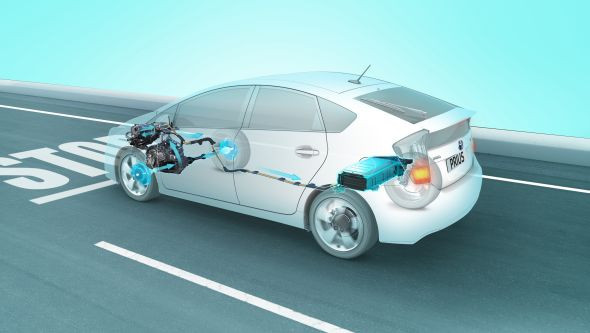 Hybrid Synergy Drive
Hybrid Synergy Drive
2.1 How Does the Power Control Unit (PCU) Optimize Efficiency?
The Power Control Unit (PCU) is a vital component in Toyota’s Hybrid Synergy Drive system, serving as the brain that manages the flow of electrical energy between the battery, electric motor, and generator. It optimizes efficiency by making real-time adjustments based on driving conditions, ensuring that the hybrid system operates at its peak performance.
Key functions of the PCU:
- Voltage Conversion: The PCU converts the voltage from the high-voltage battery to the appropriate levels needed by the electric motor and other components. This ensures that the motor receives the correct amount of power for efficient operation.
- Current Management: It regulates the current flowing to and from the battery, preventing overcharging or excessive discharge, which can damage the battery and reduce its lifespan.
- Energy Distribution: The PCU intelligently distributes energy between the gasoline engine and the electric motor, selecting the most efficient power source based on driving conditions. For instance, it can switch to electric-only mode at low speeds or during coasting, reducing fuel consumption and emissions.
- Regenerative Braking Control: The PCU manages the regenerative braking system, capturing energy during deceleration and converting it into electricity to recharge the hybrid battery. This process enhances fuel efficiency and reduces wear on the brake pads.
Benefits of the PCU:
- Improved Fuel Efficiency: By optimizing the use of both the gasoline engine and electric motor, the PCU significantly improves fuel efficiency.
- Reduced Emissions: The PCU helps minimize emissions by utilizing electric power whenever possible and ensuring that the gasoline engine operates at its most efficient points.
- Enhanced Performance: The PCU provides seamless transitions between the gasoline engine and electric motor, delivering smooth acceleration and responsive handling.
- Increased Battery Life: By carefully managing the charging and discharging of the hybrid battery, the PCU helps extend its lifespan and maintain its performance over time.
2.2 What Role Does the Power Split Device Play in the Hybrid System?
The Power Split Device is a key component in Toyota’s Hybrid Synergy Drive system, responsible for efficiently distributing power from the gasoline engine, electric motor, and generator to the wheels. This device allows the hybrid system to seamlessly blend the power sources, optimizing performance and fuel economy.
Key functions of the Power Split Device:
- Power Distribution: The Power Split Device uses a planetary gear set to split the power from the gasoline engine between the wheels and the generator. This allows the engine to drive the wheels directly while also providing power to the generator to charge the hybrid battery.
- Torque Management: It manages the torque output from both the gasoline engine and the electric motor, ensuring smooth and responsive acceleration. The device can adjust the torque split based on driving conditions, providing the optimal balance of power and efficiency.
- Regenerative Braking: The Power Split Device plays a crucial role in regenerative braking, allowing the electric motor to act as a generator during deceleration. This captures kinetic energy and converts it into electricity, which is then stored in the hybrid battery for later use.
- Seamless Transitions: The Power Split Device enables seamless transitions between the gasoline engine and electric motor, providing a smooth and refined driving experience. Drivers may not even notice when the system switches between power sources.
Benefits of the Power Split Device:
- Improved Fuel Efficiency: By efficiently managing the power flow from the gasoline engine and electric motor, the Power Split Device significantly improves fuel efficiency.
- Enhanced Performance: The device provides smooth and responsive acceleration by seamlessly blending the power from both sources.
- Reduced Emissions: The Power Split Device helps minimize emissions by allowing the hybrid system to operate in electric-only mode at low speeds or during coasting.
- Smooth Driving Experience: The seamless transitions between power sources provide a refined and comfortable driving experience.
3. How Does Regenerative Braking Work in a Toyota Hybrid?
Toyota’s hybrid system uses regenerative braking to charge the battery. When you brake or lift off the accelerator, the system captures the kinetic energy and converts it into electrical energy, which is then stored in the battery. This process significantly improves fuel efficiency, especially in stop-and-go traffic. According to the U.S. Department of Energy, regenerative braking can recover up to 70% of the energy typically lost during braking.
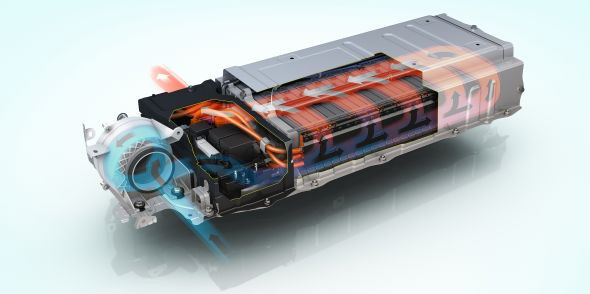 Hybrid Synergy Drive
Hybrid Synergy Drive
3.1 What Are the Benefits of Regenerative Braking?
Regenerative braking offers several key benefits:
- Improved Fuel Efficiency: Captures energy during braking and converts it into electricity, which is then stored in the hybrid battery for later use.
- Reduced Brake Wear: By using the electric motor to slow the vehicle, regenerative braking reduces the wear on traditional brake pads and rotors.
- Extended Driving Range: The electricity generated through regenerative braking helps extend the overall driving range of the hybrid vehicle.
- Lower Emissions: The regenerative braking system contributes to lower emissions by reducing the reliance on the gasoline engine.
- Enhanced Energy Efficiency: Regenerative braking systems capture kinetic energy and convert it into electrical energy, improving the vehicle’s energy efficiency.
3.2 How Does Regenerative Braking Contribute to Overall Fuel Efficiency?
Regenerative braking significantly enhances the overall fuel efficiency of a hybrid vehicle by capturing and reusing energy that would otherwise be lost as heat during braking. This process helps to reduce the reliance on the gasoline engine and extends the electric-only driving range.
Key aspects of regenerative braking and its impact on fuel efficiency:
- Energy Capture: Regenerative braking captures kinetic energy during deceleration and converts it into electrical energy.
- Electricity Storage: The electricity generated through regenerative braking is stored in the hybrid battery for later use.
- Reduced Engine Reliance: By using the stored electricity to power the electric motor, the hybrid system reduces the reliance on the gasoline engine.
- Extended Electric Range: The additional energy provided by regenerative braking helps extend the electric-only driving range of the hybrid vehicle.
- Optimized Fuel Consumption: The regenerative braking system optimizes fuel consumption by reducing the need for the gasoline engine to power the vehicle.
4. How Long Do Toyota Hybrid Batteries Last?
Toyota hybrid batteries are designed for longevity. Toyota’s standard battery warranty is five years or 100,000 miles. The batteries are substantial units that store sufficient voltage to power the car. According to Toyota, they recover over 90% of hybrid batteries and are targeting a 100% recovery rate.
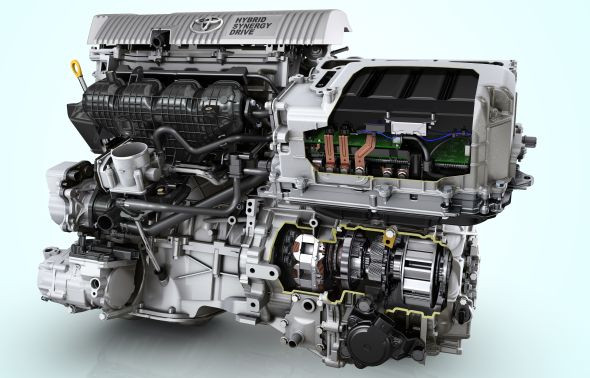 Hybrid Synergy Drive 03
Hybrid Synergy Drive 03
4.1 What Factors Affect Hybrid Battery Lifespan?
Several factors can affect the lifespan of a hybrid battery:
- Driving Habits: Aggressive driving habits, such as frequent hard acceleration and braking, can put extra strain on the hybrid battery, potentially shortening its lifespan.
- Climate: Extreme temperatures, whether hot or cold, can negatively impact the performance and lifespan of the hybrid battery.
- Maintenance: Regular maintenance, including inspections and software updates, can help ensure the hybrid battery operates at its optimal level.
- Usage Patterns: Frequent short trips, where the hybrid system doesn’t have enough time to warm up and operate efficiently, can affect the battery’s overall health.
- Battery Chemistry: The chemical composition of the hybrid battery, whether it’s nickel-metal hydride (NiMH) or lithium-ion (Li-ion), can influence its lifespan and performance characteristics.
4.2 What Happens to Hybrid Batteries at the End of Their Life?
At the end of their life, hybrid batteries can be remanufactured to make new batteries or repurposed into other forms of stationary energy storage. Toyota recovers over 90% of hybrid batteries and aims for a 100% recovery rate. This can be arranged through your Toyota dealer, ensuring responsible disposal and recycling.
5. How is the Engine in a Toyota Hybrid Different?
The internal combustion engine in a Toyota hybrid uses the Atkinson cycle, a modified four-stroke cycle that produces less heat and is more efficient than the conventional Otto cycle. This cycle cools the combustion chamber using recirculated exhaust gases, improving fuel efficiency. According to a study by the Society of Automotive Engineers, the Atkinson cycle can improve fuel efficiency by approximately 10-15% compared to the Otto cycle.
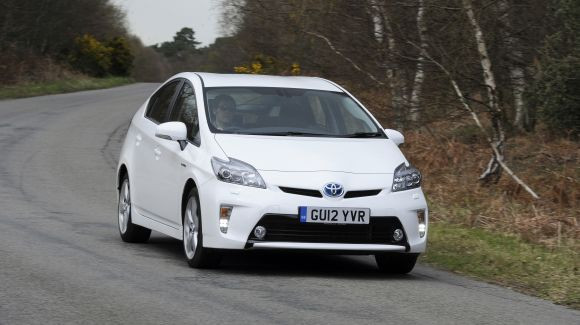 Prius dynamic moving front
Prius dynamic moving front
5.1 What is the Atkinson Cycle and How Does It Work?
The Atkinson cycle is a modified version of the traditional four-stroke combustion cycle used in internal combustion engines. It is designed to improve fuel efficiency by reducing pumping losses and extracting more energy from each combustion event.
Key characteristics of the Atkinson cycle:
- Longer Expansion Stroke: The Atkinson cycle features a longer expansion stroke compared to the compression stroke. This allows the engine to extract more energy from the combustion gases.
- Reduced Pumping Losses: By delaying the closing of the intake valve, the Atkinson cycle reduces pumping losses during the compression stroke, improving overall efficiency.
- Lower Combustion Temperatures: The Atkinson cycle operates at lower combustion temperatures, which helps reduce the formation of nitrogen oxides (NOx) emissions.
- Increased Thermal Efficiency: The Atkinson cycle is designed to maximize thermal efficiency, which is the ratio of energy extracted from the fuel to the energy input.
5.2 What Are the Advantages of Using the Atkinson Cycle in a Hybrid Engine?
The Atkinson cycle offers several advantages when used in a hybrid engine:
- Improved Fuel Efficiency: The Atkinson cycle is designed to maximize fuel efficiency by reducing pumping losses and extracting more energy from each combustion event.
- Reduced Emissions: The Atkinson cycle helps reduce emissions by operating at lower combustion temperatures and minimizing the formation of nitrogen oxides (NOx).
- Enhanced Hybrid Performance: The Atkinson cycle is well-suited for use in hybrid engines, where it can work in conjunction with an electric motor to provide optimal performance and fuel economy.
- Optimized Energy Management: The Atkinson cycle is designed to optimize energy management, allowing the hybrid system to efficiently capture and reuse energy during operation.
6. Do I Need to Drive Differently to Maximize Hybrid Technology?
No, you don’t need to alter your driving style significantly. Toyota’s hybrid system is fully automatic, optimizing its operation to minimize fuel use. Simply drive as you normally would and let the system manage the power distribution. However, smooth acceleration and gentle braking can further enhance fuel efficiency. According to a study by Oak Ridge National Laboratory, anticipating traffic conditions and avoiding sudden stops can improve fuel economy by up to 20%.
6.1 What Driving Habits Maximize Fuel Efficiency in a Toyota Hybrid?
- Smooth Acceleration: Accelerate smoothly and gradually to minimize fuel consumption.
- Gentle Braking: Apply the brakes gently to maximize regenerative braking and capture more energy.
- Anticipate Traffic: Look ahead and anticipate traffic conditions to avoid sudden stops and starts.
- Maintain Consistent Speed: Drive at a consistent speed on the highway to optimize fuel efficiency.
- Use Eco Mode: Engage the Eco mode, if available, to further optimize fuel efficiency.
6.2 Are There Any Driving Techniques Specific to Hybrid Vehicles?
While the Toyota hybrid system is designed to be fully automatic, there are a few driving techniques that can help you maximize its efficiency:
- Utilize Regenerative Braking: Take advantage of regenerative braking by gently decelerating and allowing the system to capture energy.
- Monitor Energy Flow: Pay attention to the energy flow display on the dashboard to understand how the hybrid system is working and adjust your driving accordingly.
- Drive in Electric Mode: When possible, drive in electric-only mode at low speeds to minimize fuel consumption.
- Avoid Hard Acceleration: Avoid hard acceleration, which can force the gasoline engine to engage and reduce fuel efficiency.
- Plan Your Route: Plan your route to avoid stop-and-go traffic, which can decrease fuel efficiency.
7. What are the Environmental and Economic Benefits of Driving a Toyota Hybrid?
Driving a Toyota hybrid offers significant environmental and economic benefits. Environmentally, hybrids produce fewer emissions, contributing to cleaner air. Economically, they offer better fuel economy, reducing your fuel costs. A study by the Union of Concerned Scientists found that hybrid vehicles can reduce greenhouse gas emissions by up to 60% compared to conventional gasoline vehicles.
7.1 How Do Hybrids Reduce Emissions Compared to Traditional Vehicles?
Hybrids reduce emissions through several mechanisms:
- Electric-Only Mode: Hybrids can operate in electric-only mode at low speeds and during certain driving conditions, producing zero emissions.
- Regenerative Braking: Hybrids use regenerative braking to capture energy during deceleration, reducing the need for traditional friction brakes and minimizing brake dust emissions.
- Atkinson Cycle Engine: Many hybrids use the Atkinson cycle engine, which is more fuel-efficient and produces fewer emissions than traditional Otto cycle engines.
- Start-Stop System: Hybrids often feature a start-stop system that automatically shuts off the engine when the vehicle is stopped, reducing idling emissions.
- Optimized Engine Performance: Hybrids optimize engine performance through advanced control systems, ensuring that the engine operates at its most efficient points.
7.2 What are the Long-Term Cost Savings of Owning a Hybrid?
The long-term cost savings of owning a hybrid can be substantial and include:
- Fuel Savings: Hybrids offer better fuel economy, reducing your fuel costs over the life of the vehicle.
- Maintenance Savings: Hybrids often have lower maintenance costs due to regenerative braking, which reduces wear on brake pads, and the Atkinson cycle engine, which is designed for longevity.
- Tax Incentives: Many governments offer tax incentives and rebates for hybrid vehicles, reducing the initial purchase price.
- Resale Value: Hybrids often have higher resale values than traditional vehicles due to their fuel efficiency and environmental benefits.
8. Toyota Hybrid Models Available at Miller Toyota in Boise
Miller Toyota in Boise offers a wide range of hybrid models to suit various needs and preferences.
| Model | Key Features | Fuel Economy (City/Highway) | Starting Price |
|---|---|---|---|
| Toyota Prius | Iconic hybrid with exceptional fuel efficiency and advanced technology. | 58/53 mpg | $25,075 |
| Toyota Corolla Hybrid | Compact hybrid offering a blend of efficiency, comfort, and style. | 53/52 mpg | $23,750 |
| Toyota Camry Hybrid | Mid-size hybrid with a spacious interior and refined driving experience. | 51/53 mpg | $28,825 |
| Toyota RAV4 Hybrid | Versatile hybrid SUV with ample cargo space and excellent fuel economy. | 41/38 mpg | $30,725 |
| Toyota Highlander Hybrid | Family-friendly hybrid SUV with three rows of seating and impressive fuel efficiency for its size. | 36/35 mpg | $39,825 |
Please note that prices and fuel economy figures may vary. Visit millertoyota.net for the most up-to-date information.
8.1 How Do I Choose the Right Toyota Hybrid for My Needs?
Choosing the right Toyota hybrid for your needs depends on several factors:
- Budget: Determine your budget and look for hybrid models that fit within your price range.
- Lifestyle: Consider your lifestyle and how you plan to use the vehicle. If you need a lot of cargo space, an SUV like the RAV4 Hybrid or Highlander Hybrid may be a good choice. If you prioritize fuel efficiency, the Prius or Corolla Hybrid may be a better fit.
- Driving Habits: Think about your driving habits and the types of roads you typically drive on. If you do a lot of city driving, a hybrid with excellent city fuel economy may be ideal.
- Passenger Capacity: If you need to transport a lot of passengers, consider a hybrid SUV with three rows of seating, such as the Highlander Hybrid.
- Features and Technology: Evaluate the features and technology that are important to you, such as advanced safety systems, infotainment features, and connectivity options.
8.2 What Special Offers and Incentives Are Available at Miller Toyota for Hybrid Vehicles?
Miller Toyota in Boise offers a variety of special offers and incentives for hybrid vehicles, including:
- Financing Offers: Low-interest financing rates and flexible loan terms.
- Lease Deals: Attractive lease deals with low monthly payments.
- Rebates and Incentives: Manufacturer rebates and government incentives for hybrid vehicles.
- Trade-In Offers: Competitive trade-in values for your current vehicle.
- Service Specials: Discounts on maintenance and repairs for hybrid vehicles.
Visit millertoyota.net or contact our sales team for the latest information on special offers and incentives.
9. Servicing and Maintaining Your Toyota Hybrid at Miller Toyota
Proper servicing and maintenance are crucial for keeping your Toyota hybrid running smoothly. Miller Toyota in Boise offers expert service and maintenance for all Toyota hybrid models. Our certified technicians are trained to handle the unique needs of hybrid vehicles, ensuring that your car receives the best possible care.
9.1 What are the Specific Maintenance Requirements for Toyota Hybrids?
While Toyota hybrids share many maintenance requirements with traditional vehicles, there are some specific needs to keep in mind:
- Hybrid Battery Inspection: Regular inspection of the hybrid battery to ensure it is functioning properly.
- Inverter Coolant: Periodic replacement of the inverter coolant to maintain optimal performance.
- Brake System Service: Inspection and maintenance of the brake system, including regenerative braking components.
- Fluid Checks: Regular checks of all fluids, including engine oil, coolant, and brake fluid.
- Software Updates: Keeping the hybrid system software up-to-date to ensure optimal performance and efficiency.
9.2 How Does Miller Toyota Ensure Quality Service for Hybrid Vehicles?
Miller Toyota ensures quality service for hybrid vehicles through:
- Certified Technicians: Our technicians are certified and trained to work on Toyota hybrid systems.
- Specialized Equipment: We use specialized equipment and tools designed for hybrid vehicle maintenance.
- Genuine Toyota Parts: We use genuine Toyota parts to ensure the highest quality and reliability.
- Comprehensive Inspections: We perform thorough inspections to identify any potential issues and address them proactively.
- Customer Satisfaction: We are committed to providing excellent customer service and ensuring your satisfaction with our work.
10. Frequently Asked Questions (FAQ) About Toyota Hybrid Engines
Here are some frequently asked questions about Toyota hybrid engines:
10.1 How Does a Toyota Hybrid Engine Work?
A Toyota hybrid engine combines a gasoline engine with an electric motor and battery. The system switches between the two power sources to optimize fuel efficiency.
10.2 What is the Lifespan of a Toyota Hybrid Battery?
Toyota hybrid batteries are designed to last for many years. Toyota offers a warranty of five years or 100,000 miles, but many batteries last much longer.
10.3 Do I Need to Plug in a Toyota Hybrid?
No, Toyota hybrids are self-charging. The battery is charged through regenerative braking and by the gasoline engine.
10.4 Is Maintenance More Expensive on a Toyota Hybrid?
No, maintenance is generally not more expensive on a Toyota hybrid. Regenerative braking can actually extend the life of brake pads, reducing maintenance costs.
10.5 Can a Toyota Hybrid Run on Electric Power Alone?
Yes, Toyota hybrids can run on electric power alone at low speeds and for short distances.
10.6 What is Regenerative Braking?
Regenerative braking is a system that captures the energy produced during braking and uses it to recharge the hybrid battery.
10.7 How Does the Atkinson Cycle Engine Improve Fuel Efficiency?
The Atkinson cycle engine is more efficient than traditional engines because it reduces pumping losses and extracts more energy from each combustion event.
10.8 Are Toyota Hybrids Environmentally Friendly?
Yes, Toyota hybrids produce fewer emissions than traditional gasoline vehicles, contributing to cleaner air.
10.9 What are the Benefits of Driving a Toyota Hybrid?
The benefits of driving a Toyota hybrid include better fuel economy, lower emissions, and a smooth, quiet driving experience.
10.10 Where Can I Buy a Toyota Hybrid in Boise?
You can buy a Toyota hybrid at Miller Toyota in Boise. We offer a wide range of hybrid models and expert service.
Ready to experience the benefits of a Toyota hybrid? Visit millertoyota.net to explore our inventory, schedule a test drive, and learn more about our special offers. Contact us today to find the perfect hybrid vehicle for your needs!
Miller Toyota
Address: 208 N Maple Grove Rd, Boise, ID 83704, United States
Phone: +1 (208) 376-8888
Website: millertoyota.net